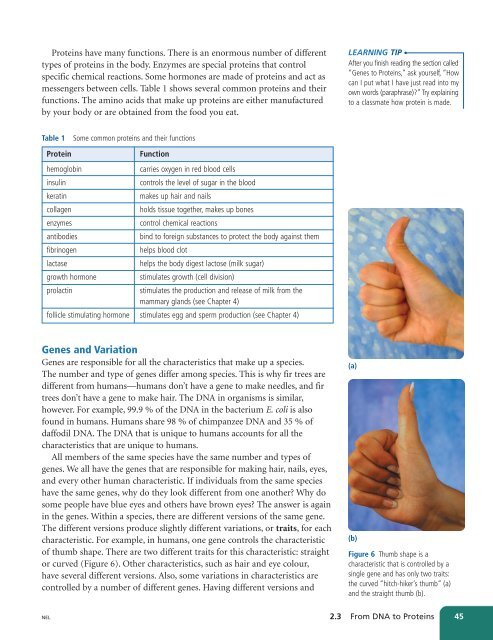Unit A Reproduction
Unit A Reproduction
Unit A Reproduction
You also want an ePaper? Increase the reach of your titles
YUMPU automatically turns print PDFs into web optimized ePapers that Google loves.
Proteins have many functions. There is an enormous number of different<br />
types of proteins in the body. Enzymes are special proteins that control<br />
specific chemical reactions. Some hormones are made of proteins and act as<br />
messengers between cells. Table 1 shows several common proteins and their<br />
functions. The amino acids that make up proteins are either manufactured<br />
by your body or are obtained from the food you eat.<br />
LEARNING TIP<br />
After you finish reading the section called<br />
“Genes to Proteins,” ask yourself, “How<br />
can I put what I have just read into my<br />
own words (paraphrase)?” Try explaining<br />
to a classmate how protein is made.<br />
Table 1<br />
Some common proteins and their functions<br />
Protein<br />
Function<br />
hemoglobin<br />
carries oxygen in red blood cells<br />
insulin<br />
controls the level of sugar in the blood<br />
keratin<br />
makes up hair and nails<br />
collagen<br />
holds tissue together, makes up bones<br />
enzymes<br />
control chemical reactions<br />
antibodies<br />
bind to foreign substances to protect the body against them<br />
fibrinogen<br />
helps blood clot<br />
lactase<br />
helps the body digest lactose (milk sugar)<br />
growth hormone<br />
stimulates growth (cell division)<br />
prolactin<br />
stimulates the production and release of milk from the<br />
mammary glands (see Chapter 4)<br />
follicle stimulating hormone stimulates egg and sperm production (see Chapter 4)<br />
Genes and Variation<br />
Genes are responsible for all the characteristics that make up a species.<br />
The number and type of genes differ among species. This is why fir trees are<br />
different from humans—humans don’t have a gene to make needles, and fir<br />
trees don’t have a gene to make hair. The DNA in organisms is similar,<br />
however. For example, 99.9 % of the DNA in the bacterium E. coli is also<br />
found in humans. Humans share 98 % of chimpanzee DNA and 35 % of<br />
daffodil DNA. The DNA that is unique to humans accounts for all the<br />
characteristics that are unique to humans.<br />
All members of the same species have the same number and types of<br />
genes. We all have the genes that are responsible for making hair, nails, eyes,<br />
and every other human characteristic. If individuals from the same species<br />
have the same genes, why do they look different from one another? Why do<br />
some people have blue eyes and others have brown eyes? The answer is again<br />
in the genes. Within a species, there are different versions of the same gene.<br />
The different versions produce slightly different variations, or traits,for each<br />
characteristic. For example, in humans, one gene controls the characteristic<br />
of thumb shape. There are two different traits for this characteristic: straight<br />
or curved (Figure 6). Other characteristics, such as hair and eye colour,<br />
have several different versions. Also, some variations in characteristics are<br />
controlled by a number of different genes. Having different versions and<br />
(a)<br />
(b)<br />
Figure 6 Thumb shape is a<br />
characteristic that is controlled by a<br />
single gene and has only two traits:<br />
the curved “hitch-hiker’s thumb” (a)<br />
and the straight thumb (b).<br />
NEL<br />
2.3 From DNA to Proteins 45

















